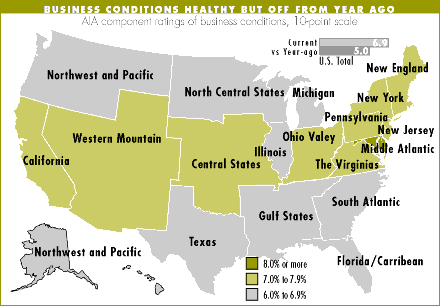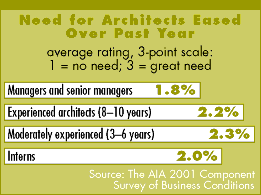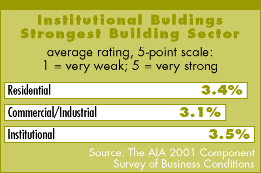
Most regions saw slowdowns even before factoring in terrorist attacks

AIA Chief Economist
• While most AIA components report healthy
business conditions in the areas that they serve, a majority reports that
the economic environment has deteriorated from a year ago.
• Architects in the middle of the experience spectrum are most in
demand.
• Institutional buildings are viewed as the strongest construction
sector in most regions, although residential activity is generally viewed
as remaining very solid.
These are the key findings of "The AIA 2001 Component Survey of Business Conditions," an annual survey of key AIA component executives and officers. Respondents are asked to rate business conditions for their area and compare them to those of a year ago. Additionally, they are asked to respond to the need for architect staffing at firms in their area and to the health of key building sectors. Almost 200 responses were received across the 18 AIA regions. Survey responses were returned between September 4 and September 21, thereby covering the period of the terrorists' attacks.
Business conditions
healthy but faltering
On a 10-point scale, with 1 being "terrible" and 10 being "couldn't
be better," the average rating for current area business conditions
was 6.9. Over half of the regions were rated a 7 or better, with the Middle
Atlantic region having the top score, averaging 8.0 among component executives
and officers in that region. The average score for each region was 6.0
or higher. In the 2000 survey, the average rating of business conditions
was 8.0, with no region scoring below 7.3.

![]()
![]()
Though business conditions are generally viewed as healthy, most regions report an easing from the strong pace of a year-ago. On a 10-point scale with 1 being "much worse" and 10 being "much better," the average rating for current conditions as compared to last year was 5.0, on the low side of "about the same." Fully half of the regions report conditions as weaker than a year ago, while most of the others report that conditions are comparable to last year. Only two regions—New York and New Jersey—report conditions as modestly improved from year-ago levels. A year ago, the average rating for conditions compared to the previous year was 6.6, with no region scoring below 5.6.
Project architects
in greatest need
Components report that the greatest staffing needs are for moderately
experienced architects (3–6 years of experience) followed closely
by architects with 8–10 years of experience. Almost a third of the
respondents reported a great need in their area for architects at each
of these experience levels. Interns were next on the list; about two-thirds
of respondents indicated some need in their area for interns. The remainder
was about equally split between those indicating a great need for interns
and those indicating no need. Very few respondents indicated a great need
for managers and senior managers in their areas. Similarly, in the 2000
survey, the greatest need was cited for moderately experienced and experienced
architects.
 Though
respondents in most regions indicated at least some need for project architect
positions (both 3–6 and 8–10 years of experience), those in
some regions expressed a more substantial need. Respondents in most AIA
regions in the Northeast and Midwest indicated an ongoing need for architects
at these experience levels. Component representatives in New York, the
Ohio Valley, and New England indicated a great need for moderately experienced
architects.
Though
respondents in most regions indicated at least some need for project architect
positions (both 3–6 and 8–10 years of experience), those in
some regions expressed a more substantial need. Respondents in most AIA
regions in the Northeast and Midwest indicated an ongoing need for architects
at these experience levels. Component representatives in New York, the
Ohio Valley, and New England indicated a great need for moderately experienced
architects.
Need for interns was strongest in the Northeast, topped by Pennsylvania and New York. Component representatives in the Middle Atlantic and New Jersey regions indicated a strong need for managers and senior managers.

Institutional buildings
remain the strongest construction sector
Respondents in most regions rate the residential and institutional sectors
as strong and the commercial/industrial sector as moderate. Respondents
from the Ohio Valley region were the most optimistic about conditions
in the institutional sector, while those in the Middle Atlantic region
had the most favorable view of the residential sector.
 Needless
to say, the construction sector has changed dramatically with the rest
of the economy since the events of September 11. While many respondents
acknowledged that conditions were likely to change in the weeks and months
ahead, it is still too early to gauge the precise nature of the change.
Dodge Analytics, the construction analysis and forecasting arm of the
McGraw-Hill Construction Information Group, has revised their construction
outlook for the remainder of 2001 and into 2002 in the light of these
events.
Needless
to say, the construction sector has changed dramatically with the rest
of the economy since the events of September 11. While many respondents
acknowledged that conditions were likely to change in the weeks and months
ahead, it is still too early to gauge the precise nature of the change.
Dodge Analytics, the construction analysis and forecasting arm of the
McGraw-Hill Construction Information Group, has revised their construction
outlook for the remainder of 2001 and into 2002 in the light of these
events.
Dodge Analytics now is projecting a steep decline in commercial and industrial activity for the remainder of 2001 and further erosion in 2002 for these sectors. The institutional and residential sectors are projected to remain essentially flat for the next 15 months. However, these trends were already in place through the first eight months of the year. Though August, Dodge Analytics reports, construction contracts for stores were down 10%, offices down 14%, hotels down 15%, and warehouses down 16%. Once construction plans have been reviewed in the light of recent events, Dodge Analytics predicts that the hotel sector will be the hardest hit and will likely remain in a downturn through 2003. The other commercial sectors are expected to begin their recovery later in 2002. However, until the full economic fallout from these events is determined, it's difficult to accurately assess the impact on the construction sector.
Copyright 2001 The American Institute of Architects. All rights reserved.
![]()